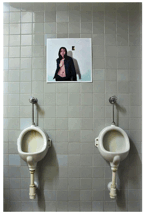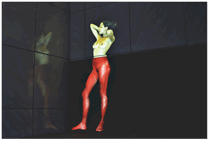Brief Description of Claudia Sandoval’s Photographic Work I’ve been worried about inquiries related to the relation photography-context, developing essays in both the virtual and the material world.
In “Intimate Duchamp” is done an intervention to the toilets of the Museum of Modern Art, La Tertulia, Colombia. For this work the Duchamp's allegory is inverted bringing images to a museum's toilet, questioning the expositional places in a museum.
“A Latin-American in Italy” was done at the Benetton’s research center Fabrica in Treviso, Italy, and consists in the image of a naked woman around Treviso. The intervention describes the racism still present in some places of Europe and the treatment to women as sexual objects. These images are pointing to the formal question of photography and its critical use when dislocated to a public space.
“Intervening Bogotá” brings to question Wienfried Noth's proposal about photography as a tool for representing the truth but at the same time to lie. In this case the lie is made clear exposing the different times when the photographs were taken, placing them together to share a single space in the image, expliciting the lie of the photographic matter. The essay of pasting on the walls of cold and industrial capital of Colombia, one natural size image of a naked man in a nudist beach and another of three men also naked in a beach, wants to re-create the reflections about the impersonal places and the time of our routine given to meaningless transits, re-signifying the relation of the space and territory with the body. A questions about the subject in photography and how it is always a representation, took me to subvert the sense real/virtual developing the essays “Essay About the Night”, Sao Paulo, 2007, and “Essay about the Youth”, Berlin, 2008.
In “Essay About the Night” the portrait in is done to a projected image of the subject in his/her home, substituting the material subject, pointing to the idea of the photographic subject as a representation, while at the same time it creates this way a visual common denominator that unites two opposed worlds of Sao Paulo: the one of the sex workers and on the young “party people”. This way, two aspects of the same night are exhibited in the essay.
In the “Essay about the Youth” the idea of the ephemeral character of generations through time is represented in portraits where the people are merged with the place they are photographed on. In these portraits the people are an unstable element of composition, symbolizing the generations that disappear and change constantly, while the architecture is a more stable element through time, changing in a more slowly proportion. At the same time, my inquiries about photography and its context brought me to developed a research about the place that photography occupies when used as part of multimedia art pieces for the internet. |




